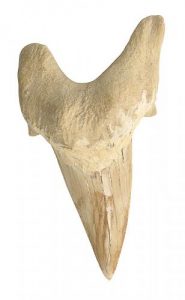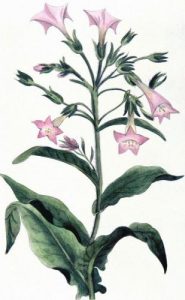Follow Marlborough Point Road down to the eastern tip of Stafford County, and you will pass by lots of new housing mushrooming into the forests and fields that were once favored by both the American Indians and colonial settlers. This section of the county is home to not just centuries of local history but millennia.
Crocodiles in Stafford County?
Beachcombers have long found signs of ancient life on the banks near Marlborough Point, and these are remnants of a world ruined by simple geologic forces. Fossilized teeth from crocodiles and sharks that could grow 30 feet long as well as fossil rays and sea snail shells may be found along the beaches. These specimens date from the Paleocene-Eocene periods, about 35 to 65 million years ago--just after the extinction of the dinosaurs. The Eocene period was known for warm temperatures and changeovers in animal types. Our Tidewater land lay underwater in coastal shallows. The Chesapeake Bay Meteor also struck during the Eocene period, sending millions of tons of water into the air and quite possibly resulting in a tsunami that may have overtopped the Blue Ridge Mountains.
A Rich Land for Native Americans
In more modern times, the Potomac River, teeming with fish and attracting other wildlife, was greatly appreciated by the local tribes of American Indians, the largest of whom was called the Patawomeke or Potomac. Potomac may be a bit of a misnomer for the river itself, or the town for that matter. Captain Smith was in the habit of naming rivers for the tribes who inhabited the area.
Anthropologist William Wallace Tooker believed the proper name for the town at was probably Paspatanzie. Paspatanzie breaks down into Pasp-, "a bursting forth or flowing out; " otan, "a town; " zie, which is a diminutive. So according to Tooker, Paspatanzie would be a town at the mouth of a stream, flowing into a larger river. Today, Passapatanzy is the name of an unincorporated town in neighboring King George County. It, too, has a creek flowing into the Potomac.
The village Smith visited was located at the end of Indian Point Road, and it was the site of Pocahontas’ kidnapping in 1613. As so often happens with coastal settlements, the native village has now almost completely eroded into the river. Archaeological excavations on an earlier village showed that the Potomacs had palisades to protect them from enemy tribes. They were expected to last about a dozen years and then were rebuilt. The Potomacs had built many permanent dwellings and public buildings, and had upwards of 1,000 acres in cultivation. But they were soon to have company.
Israel Daniel Rupp recounted a missionary visit by the Governor of Maryland and a Jesuit priest in March of 1634 in his An Original History of the Religious Denominations at Present Existing in the United States (1844):
It was on the 23d of March, 1634, the festival of the Annunciation of the ever blessed Virgin, and on St. Clement's Island, in the Potomac, that the divine sacrifice of the mass was for the first time offered up to God, in this portion of America. Governor Calvert, accompanied by Father Althano, then sailed up the river, landing first on the Virginia side, at an Indian town called Potomac, and now known as New Marlborough, or Marlborough Point. The Jesuit Father explained to the assembled Indians the chief mysteries of the Christian religion, as well as the peaceful and benevolent motives that actuated their unexpected visitors. It is remarkable that his interpreter on this occasion was a Protestant. Leaving the chief and his people favourably impressed, and even gratified at the arrival of the strangers, the governor sailed about twenty-five miles up the river, to Piscataway, in Maryland, the residence of the great king or chief of the neighbouring tribes.
By 1662, the Potomacs’ identity as a powerful and cohesive tribe had all but vanished.
A Town Doomed by Profit
Early Virginia colonists settled along the major rivers. Whereas today land might be advertised as having road access, back in those days, the rivers were the roads, and the major rivers, such as the Potomac and the Rappahannock, were the highways, readily leading to the Chesapeake, itself a superhighway to the Atlantic and the way back home for British traders and affluent colonists. The moorings and docks on large estates were like unto modern driveways, visited by neighbors, traders, and other travelers.
Britain expected its colonies to be profitable, and tobacco made them so. Taxes on tobacco brought England its share of the riches. However, with such easy access to the plantations, traders were inclined to deal directly with the planters. Over the years, the colonial government tried to create port towns that could serve as central places for tobacco inspection and purchase. Some proposed towns did eventually flourish, but others such as Marlborough did not. Part of the problem was Mother England’s desire to keep her colonies dependent.
The British Crown was not so keen to establish genuine working towns in tobacco-producing colonies. They were concerned that if colonists became more diversified, they might stop producing so much profitable tobacco and instead take up more practical concerns, such as producing their own wool. Britain wanted to protect its export of woolen goods and other manufactured goods to the needy colonies and keep the taxes from tobacco flowing into its royal coffers whilst keeping her homeland merchant citizens happy. Yet the demands for some sort of town would not be denied, and the colonial government continued to push for establishing towns. Marlborough was designated as Stafford’s county seat from 1691 to about 1718.
By the early 1700s, a few gentleman investors bought plats of land on the Marlborough Point. The town was designed, and some rudimentary houses were put in place, along with an ordinary (tavern), a courthouse, and a jail. Yet in just a few years, what progress had been made seemed to be on the way to ruin. The town simply was not attracting enough investors, traders, or merchants. It was on its way to decline, and might have vanished altogether were it not for a brash young immigrant from Dublin.
An Ambitious Young Man
 John Mercer, whose portrait may be found in A Cultural History of Marlborough, was only sixteen years old when he immigrated to America. Born in Ireland on February 6, 1704, he was the son of a merchant of English descent and had attended Trinity College. John Mercer had no great family to sustain him nor did he require it. He declared: “Except for my education I never got a shilling of my fathers or any other relations estate, every penny I ever got has been of my own industry and with as much fatigue as most people have undergone.
John Mercer, whose portrait may be found in A Cultural History of Marlborough, was only sixteen years old when he immigrated to America. Born in Ireland on February 6, 1704, he was the son of a merchant of English descent and had attended Trinity College. John Mercer had no great family to sustain him nor did he require it. He declared: “Except for my education I never got a shilling of my fathers or any other relations estate, every penny I ever got has been of my own industry and with as much fatigue as most people have undergone.
Once in the colonies, he sailed his sloop up and down the river, trading goods, and making contacts. He also studied law and began to practice it in Maryland and would later also practice in Virginia. He was known for his hot temper and was censured on more than one occasion for his behavior in court.
John Mercer made close friends with the already established Mason family of Gunston Hall. On June 10, 1725, he married Catherine Mason, and the two very young people set up their home in the only house left standing in Marlborough. He soon took over the deserted town and began buying up nearby land to create a tobacco plantation that employed enslaved persons to labor. He was in a formidable position when the Tobacco Inspection Act of 1730 called for the establishment of official tobacco warehouses. His were built and ready to go by 1732, but as quickly as 1735 they were in disuse. Marlborough was declared to be inconvenient and soon a better official site was found at Aquia Creek.
The Town Revives with Mercer’s Fortunes
Despite this setback, John Mercer continued building. He built himself another new yet simple house in 1731. He built Mercer wharf, a tavern, a cider mill, a water mill, a windmill, a brewery, tobacco barns, a glass factory, a malt house, two granaries, three corn houses, a cooper’s shop, cabins to house enslaved people, an overseer’s house, a racetrack and stables. In 1746, he began building his own manor house, hiring a Williamsburg craftsman to do the brickwork. He also had his own fleet of sailing vessels to take his tobacco to England.
Mercer, like many of his contemporaries, imported a blooded racehorse. His was named Ranter, and Mercer collected stud fees on him from about 1763 onward, though this would not ultimately prove to be a sound investment. Like Thomas Jefferson, another Virginia patriot, he was also something of an amateur botanist. He kept careful notes in his journal of what was planted and what was blooming on his estate. He noted many native species as well as what were his own introductions.
The Marlborough Town renaissance lasted for about 40 years, but, towards the end of Mercer’s life, the more speculative ventures, such as a poorly-designed and managed brewery producing a rank beverage, drained the family’s resources rather than adding to them. But other spirits were brewing than bad beer in colonial Virginia. By the 1760s, patriotic sentiment was rising as surely as the tide on the Potomac.
Patriot Days
Back in 1734, John Mercer had his law license suspended because of his insolent and disrespectful behavior to the judges. He was markedly anti-authoritarian and a radical democrat who was not beyond convincing fellow citizens that the justices were in error. Mercer’s license was reinstated, but his character remained unrepentant.
It was into this household that eleven-year-old George Mason was brought upon the death of his father. The future statesman and co-author of the Bill of Rights came to Marlborough in 1735 to live with his uncle, John Mercer. The Marlborough house had a huge library for the time—more than 1500 volumes—which included classical writings and many law books, some of which Mercer abridged and compiled.
“Your humble Servant, Anglo-Americanus”
Argumentative as John Mercer was in the courtroom, he was equally vocal on matters political. When the Stamp Act of 1765 was announced, Mercer was quick to declare it unconstitutional and set out to share his views in the Virginia Gazette. He made out the table of proposed taxes and included an introduction which the publisher refused to print. The paper had been forbidden to publish any remarks on the Act by Governor Fauquier, so they published just the tables.
His censored argument against the Stamp Act was partly based on the Magna Carta’s guarantee that justice would not be denied, delayed, or sold. Taxes on the many pieces of legal paper required in the court process would, in essence, put a price on justice which, according to Mercer, “not one in a hundred will be able to pay the purchase Money.”
Mercer called on patriots to defy the false authority assumed by Parliament, daring them to come forth: "What, not one Patriot! None that thought the Sir-name of Americanus worth acquiring by stepping in, to divert the fatal thunderbolt." He also used Biblical examples to hammer home his point, comparing the English authorities to Pharaoh and Americans to oppressed Israelites, paraphrasing from the book of Exodus.
Despite its ban, the remarks found their way into the hands of some of the burgesses and Mercer’s friends who found his concrete if flamboyant arguments compelling. His contemporary, Edmund Randolph, believed that this preface was important—that John Mercer had been the first in Virginia to plainly put forth the arguments against the Stamp Act. Mercer, serving as chief justice of Stafford’s magistrates penned a letter that he and his fellows refused to serve after the Act went into effect so that they would not be involved "in the Destruction of our Country's most essential Rights and Liberties."
With John Mercer’s Passing, So Follows Marlborough
 The man who argued so stubbornly for the rights of his fellow colonists died before he could see the Revolutionary War begin or the new country created by its victory. He died at his home, "Marlborough," on October 14, 1768. His son, James Mercer, kept Marlborough through the American Revolution and until his death, but he was forced to sell off many parts of his father’s estate including the family’s coach, the silver, the highly-esteemed “black cattle,” and his father’s famous library. He did not sell off the enslaved people at that time.
The man who argued so stubbornly for the rights of his fellow colonists died before he could see the Revolutionary War begin or the new country created by its victory. He died at his home, "Marlborough," on October 14, 1768. His son, James Mercer, kept Marlborough through the American Revolution and until his death, but he was forced to sell off many parts of his father’s estate including the family’s coach, the silver, the highly-esteemed “black cattle,” and his father’s famous library. He did not sell off the enslaved people at that time.
According to a letter from the widow of Major George Thornton, Marlborough was one of several plantation homes bombarded by Lord Dunmore’s fleet in 1776, but it was not burned. John Francis Mercer lived there after the Revolution, and, in 1799--some years after his half-brother James’ death, this younger brother offered the Potomac Neck properties for sale or rent including overseer’s houses, quarters for enslaved people, and corn houses. He also made available “30 or 40 Virginia born slaves, in families, who are resident on the lands.”
John Cooke of Stafford County bought Marlborough. His insurance policy listed a “Brick Dwelling House one Story high covered with wood, 108 feet 8 Inches long by 28 ½ feet wide, a Cellar under about half the House.” Running the length of the house was a Portico 108 feet 8 inches by 8 feet 4 inches.” A “Porch 10 by 5 f.” stood in the front of the portico and another was located on the northeast corner of the building, 8 feet by 6 feet. The house was used not by Cooke but by his overseer. Recreated drawings of the house may be found in A Cultural History of Marlborough.
By the time John Cooke sold the property in 1819, no buildings were mentioned—only the land and the possibility for fishing. Mercer’s Marlborough was no more.
The Children of John Mercer
John Mercer had two wives, with whom he had eleven children, five of whom lived to maturity. George (1733-1784) was praised for his bravery as Colonel George Washington’s aide-de-camp during the French & Indian War. Yet later he fled to England when commissioned to enforce the very Stamp Act his father protested so vigorously.
John Mercer’s second son, John Fenton (1735-1756), served in Captain Robert Stewart's company. He was promoted to captain and sent to Edwards's Fort in Bath County, Virginia. In April of 1756, he was killed by Shawnee and Delaware Indians allied with the French while commanding a scouting party of one hundred men at the Battle of Great Cacapon (also known as Mercer’s Massacre).
James Mercer (1736-1793) was a captain in the French and Indian War, commanding Fort Loudoun in Winchester, Virginia. He served as a member of the House of Burgesses, and in 1774 was a member of the General Assembly. In 1779, he was sent as a delegate to the Continental Congress. A lawyer like his father, he served as judge of the first Virginia Court of Appeals from 1789 until his death in 1793. He married the daughter of Charles Dick, and they resided in Fredericksburg for a time.
Another son, John Francis Mercer (1759-1821), served as a captain in the 3rd Virginia Regiment in the Continental Army and became governor of Maryland from 1801 to 1803.
His daughter, Grace Fenton (1751-1814) married Muscoe Garnett of Essex County in 1767. The father of the bride was pleased with the match, declaring his son-in-law “entirely clear of every modish vice.” When the wedding took place just one year before his death, John Mercer had become a father for the eleventh time. Grace and her new husband would build Elmwood, which would also become famous for its library, created by their son, James Mercer Garnett. Unlike Grandfather John Mercer’s own library, this collection would remain intact and pass to the University of Virginia where many of the family had developed connections.
Civil War Times
Marlborough continued to have some importance as a connection for steamboats and stagecoaches as early as 1828. The time between Washington and Richmond was 26 hours, 24 hours sooner than by any other route.
During most of the Civil War, the area surrounding Marlborough was occupied by Union forces.
Windmill Point, a union field hospital, was located on Marlborough Point, at the site of John Mercer’s long ago windmill. In his army letters, U.S. Christian Commission field agent John A. Cole described his visit to the hospital: “I have just come from Windmill Point Hospital where are about 4,000 sick soldiers, some of them have suffered terribly and many die daily…. many lives I believe have been saved within the past three weeks and many souls have passed from darkness into light.” (Feb. 10, 1863)
Some of those who died at Windmill Point Hospital were buried on "Marlboro Point." They were later reburied in the Fredericksburg National Cemetery.
The Potomac River was the site of one of the first naval engagements in the Civil War. Not very far from Marlborough at Aquia Landing, Confederates built their defenses to cover the Richmond, Fredericksburg, and Potomac Railroad terminus and steamboat landing. A battery of five Confederate guns was stationed at Marlborough Point. On August 23, 1861, Colonel R. M. Cary, Thirtieth Virginia Infantry, gave an action report from his position at Marlborough Point, in which he detailed a 40-minute encounter in which his officers and men "behaved with proper coolness and deliberation." Aquia Landing was abandoned by the C.S.A. in March of 1862 to Union forces who put their own batteries in place. Visitors to Aquia Landing Park can get a good view of the land and water near Marlborough while enjoying a day at the riverfront beach.
Modern Developments
 Farming was still a part of the region’s landscape in the 1950s, but in recent decades land on Marlborough Point has been used as home sites for many modern structures, and private property encloses the historic sites. But the proposed Accokeek Creek National Wildlife Refuge, at the confluence of the Potomac and Accokeek creeks, could preserve 700 acres of freshwater tidal marshes and 1,000 acres of floodplain forests. Its soil is rich with calcium from creatures that swam through the area millions of years ago. This nearby land, called Crow’s Nest Natural Area, is filled with native plant and animal species that predate the coming of any humans.
Farming was still a part of the region’s landscape in the 1950s, but in recent decades land on Marlborough Point has been used as home sites for many modern structures, and private property encloses the historic sites. But the proposed Accokeek Creek National Wildlife Refuge, at the confluence of the Potomac and Accokeek creeks, could preserve 700 acres of freshwater tidal marshes and 1,000 acres of floodplain forests. Its soil is rich with calcium from creatures that swam through the area millions of years ago. This nearby land, called Crow’s Nest Natural Area, is filled with native plant and animal species that predate the coming of any humans.
Bibliography:
"The Algonquian Terms Patawomeke and Massawomeke" Author(s): William Wallace Tooker. Source: American Anthropologist, Vol. 7, No. 2 (Apr., 1894), pp. 174-185. Published by: Blackwell Publishing on behalf of the American Anthropological Association Stable URL: http://www.jstor.org/stable/658539 Accessed: 03/11/2009 11:26
*"Georgetown and the Tobacco Trade, 1751-1783" Author(s): Richard K. MacMaster. Source: Records of the Columbia Historical Society, Washington, D.C., Vol. 66/68, The 46th separately bound book (1966/1968), pp. 1-33. Published by: Historical Society of Washington, D.C. Stable URL: http://www.jstor.org/stable/40067244 Accessed: 03/11/2009 11:32
The Cultural History of Marlborough, Virginia by C. Malcolm Watkins. Washington: Smithsonian Institution Press, 1968.
Biographical Sketch of Hon. James Mercer Garnett of Elmwood, Essex County, Virginia with Mercer-Garnett and Mercer Genealogies by James Mercer Garnett. Richmond, VA: Whittet & Shepperson Printers, 1910.
*"Historic Fort Washington on the Potomac" Author(s): James Dudley Morgan. Source: Records of the Columbia Historical Society, Washington, D.C., Vol. 7, (1904), pp. 1-19. Published by: Historical Society of Washington, D.C. Stable URL: http://www.jstor.org/stable/40066837
*"James Mercer "Author(s): James Mercer Garnett. Source: The William and Mary Quarterly, Vol. 17, No. 2 (Oct., 1908), pp. 85-99. Published by: Omohundro Institute of Early American History and Culture. Stable URL: http://www.jstor.org/stable/1916055 Accessed: 03/11/2009 11:18
John Francis Mercer of Stafford County: A Neglected Patriot... by Jeffrey Garth Edmunds (CRRL)
*"John Mercer and the Stamp Act in Virginia, 1764-1765" Author(s): J. A. Leo Lemay. Source: The Virginia Magazine of History and Biography, Vol. 91, No. 1 (Jan., 1983), pp. 3-38 Published by: Virginia Historical Society. Stable URL: http://www.jstor.org/stable/4248608 Accessed: 03/11/2009 11:21
*"John Mercer's Notes on Plants" Author(s): Sarah P. Stetson. Source: The Virginia Magazine of History and Biography, Vol. 61, No. 1 (Jan., 1953), pp. 34-44 Published by: Virginia Historical Society. Stable URL: http://www.jstor.org/stable/4245900 Accessed: 03/11/2009 11:19
*"The Last Fifteen Years of the House of Burgesses of Virginia, 1761-1776" Author(s): James Mercer Garnett. Source: The Virginia Magazine of History and Biography, Vol. 18, No. 2 (Apr., 1910), pp. 213- 223 Published by: Virginia Historical Society. Stable URL: http://www.jstor.org/stable/4243059 Accessed: 03/11/2009 11:24
An Original History of the Religious Denominations at Present Existing in the United States by Israel Daniel Rupp. Philadelphia: J.Y. Humphreys, 1844.
*"Stafford and King George Courthouses and the Fate of Marlborough, Port of Entry" Author(s): Ralph Happel. Source: The Virginia Magazine of History and Biography, Vol. 66, No. 2 (Apr., 1958), pp. 183- 194. Published by: Virginia Historical Society. Stable URL: http://www.jstor.org/stable/4246427 Accessed: 03/11/2009 11:14
*"The Tidewater Colonies: Town Planning in the 17th Century" Author(s): John W. Reps. Source: The Town Planning Review, Vol. 34, No. 1 (Apr., 1963), pp. 27-38. Published by: Liverpool University Press. Stable URL: http://www.jstor.org/stable/40103671 Accessed: 03/11/2009 11:28
They Called Stafford Home: The Development of Stafford County, Virginia, from 1600 until 1865 by Jerrilynn Eby. Bowie, MD: Heritage Books, Inc, 1977.
CRRL card holders may use the JSTOR database to retrieve articles marked (*) at no charge.





